Comments / Questions (50)
![]() Marianne Kristoffersen wrote:
Marianne Kristoffersen wrote:
Jag kommer att repa upp den här västen som jag har påbörjat. Rörig beskrivning tyvärr. Jag kanske hittar något annat......
08.11.2024 - 12:03
![]() Marianne Kristoffersen wrote:
Marianne Kristoffersen wrote:
SNED AXEL: Varför är det olika på fram och bakstycket?
07.11.2024 - 20:17DROPS Design answered:
Hej Marianne. Du ska sätt maskor mot ärmhålet på en tråd till sned axel på samma sätt som du gjorde på bakstycket enligt beskrivningen. Mvh DROPS Design
08.11.2024 - 11:54
![]() Marianne Krissttoffersen wrote:
Marianne Krissttoffersen wrote:
Fråga: det här är rörigt beskrivet, finns det någon video på detta? SNED AXEL: Varför olika? Sätt de med, stickas maskorna innan de sätts på tråd. Sätt 7-7-7-7-8-10-10 maskorna på tråd. Alla maskor har nu maskats av eller satts på tråd. Sätt tillbaka de 20-21-23-26-28-32 maskorna från tråden på rundsticka 6. Sticka 1 ...
07.11.2024 - 20:15
![]() Ann wrote:
Ann wrote:
Instruksjonene kan være ufullstendige eller feil for kragen: Hvis du bruker pinne 6 per 1 cm = 1,4 masker, vil halsen ha en diameter på mindre enn 50 cm på 60-68 masker. I veiledningen står det til og med at man skal bruke pinne 4,5. Jeg tror ikke dette vil passe over hodet på en voksen kvinne på noen som helst måte. Kan du vennligst oppdatere instruksjonen for 50-52-54-58-60-62 cm overskrift?
22.10.2024 - 00:27
![]() Ann wrote:
Ann wrote:
Hi Jette, Her har den en omkreds på 2 x for- eller bagside. For at sikre, at den sidder behageligt, skal du lægge en margin til den faktiske omkreds. Tag et målebånd, og find ud af, hvor meget plads du har brug for. Jeg ville altid gå mindst en størrelse op. Det er muligt at strikke en anden størrelse forneden end foroven. Inden du går i gang, bør du tjekke din individuelle 10 x 10 cm for at se, om det angivne antal masker faktisk er korrekt, afhængigt af hvor stramt du strikker.
22.10.2024 - 00:00
![]() Jette Nielsen wrote:
Jette Nielsen wrote:
Hvad svarer de enkelte størrelser til i brystmål?
21.10.2024 - 08:02DROPS Design answered:
Hej Jette, du finder målene på vesten i måleskitsen nederst i opskriften. Brystmål i den mindste størrelse bliver da 50x2=100 cm i omkreds :)
22.10.2024 - 15:47
![]() Veerle wrote:
Veerle wrote:
Dankuwel Ann !
13.10.2024 - 20:34
![]() Ann wrote:
Ann wrote:
My previous comment in EN - front part - example size S: Before you decrease at the throat you have 64 stitches for size S (after you have already decreased the 2 x 3 = 6 stitches for the armhole). Then cast off the middle 16 stitches for the throat. This leaves 24 stitches on both sides (64 - 16 = 48 stitches : 2 = 24). Each side: 24 stitches minus 4 stitches for the throat = leaves 20 stitches, which will be taken off as shoulder by minus 7, minus 7, minus 6 (total 20).
13.10.2024 - 11:44
![]() Ann wrote:
Ann wrote:
Hi Veerle. Ik wil de trui ook graag in S breien :-) Voordat je mindert bij de halslijn, heb je 64 steken voor maat S (nadat de 2 x 3 steken voor het armsgat al verminderd zijn). Daarna doe je de middelste 16 steken af voor de halslijn. Er blijven dan 24 steken over aan elke kant (64 - 16 = 48 steken : 2 = 24). Elke kant: 24 steken min extra 4 steken voor de halslijn. Dit resulteert in 20 steken, die worden afnemen met min 7, min 7, min 6 (totaal 20) voor de schouder.
13.10.2024 - 11:36
![]() Veerle wrote:
Veerle wrote:
Zou iemand mijn vraag van 6 oktober kunnen beantwoorden?
11.10.2024 - 08:46
Cherry Sorbet Vest#cherrysorbetvest |
|
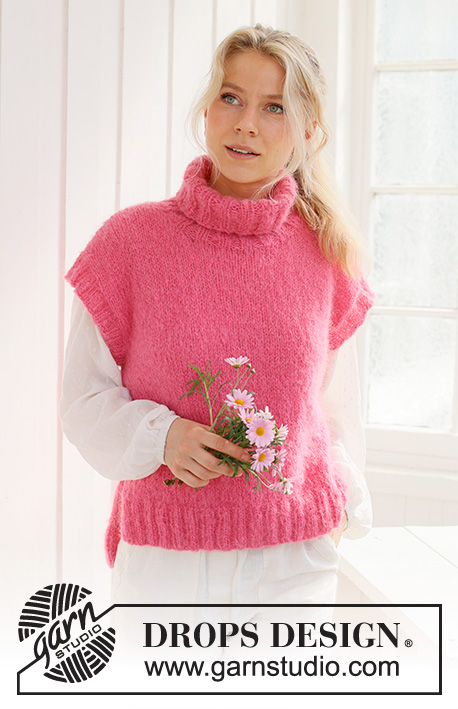 |
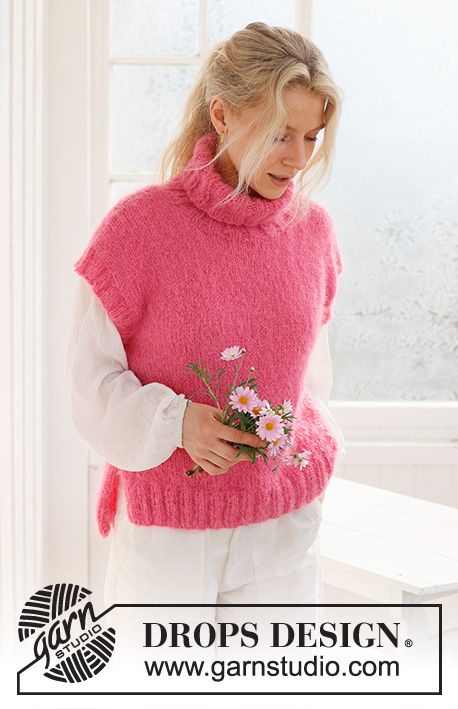 |
Knitted vest in DROPS Melody. The piece is worked bottom up, in stocking stitch, with high neck and split in the sides. Sizes S – XXXL.
DROPS 231-59 |
|
|
------------------------------------------------------- EXPLANATIONS FOR THE PATTERN: ------------------------------------------------------- RIDGE/GARTER STITCH (worked back and forth): Knit all rows. 1 ridge = knit 2 rows. ------------------------------------------------------- START THE PIECE HERE: ------------------------------------------------------- VEST - SHORT OVERVIEW OF THE PIECE: The front and back pieces are worked separately, back and forth and bottom up. The sleeve-edges and neck are worked to finish. The back piece is 6 cm longer than the front piece. BACK PIECE: Cast on 82-86-94-102-110-118 stitches with circular needle size 4.5 mm and DROPS Melody. Work as follows from the right side: 2 stitches in GARTER STITCH – read description above, work rib (knit 2, purl 2) until there are 4 stitches left, knit 2 and 2 stitches in garter stitch. Continue this rib for 8 cm, with the next row from the right side. Work as follows: 1 stitch in garter stitch, knit 80-84-92-100-108-116 and decrease 12-12-14-14-14-14 stitches evenly over these stitches, 1 edge stitch in garter stitch = 70-74-80-88-96-104 stitches. Change to circular needle size 6 mm and work stocking stitch with 1 stitch in garter stitch on each side. REMEMBER THE KNITTING TENSION! When the piece measures 33-34-35-36-37-38 cm, cast off 3-3-4-4-5-5 stitches at the beginning of the next 2 rows for the armholes = 64-68-72-80-86-94 stitches. Continue with stocking stitch. When the piece measures 56-58-60-62-64-66 cm, cast off the middle 24-26-26-28-30-30 stitches for the neck and finish each shoulder separately. DIAGONAL SHOULDERS: Place the outermost stitches towards armhole on a thread for the diagonal shoulders, but to avoid cutting the strand work them first. Place 7-7-8-9-9-11 stitches on a thread two times, then the last 6-7-7-8-10-10 stitches. All stitches have now been cast off or placed on the thread. Place the 20-21-23-26-28-32 stitches from the thread back on circular needle size 6 mm. Purl 1 row from the wrong side; to avoid holes where you turned in the middle of the row, pick up the strand between 2 stitches and purl it twisted together with the first stitch on the left needle. Then cast off with knit a little loosely from the right side. The piece measures approx. 60-62-64-66-68-70 cm from the cast-on edge to the highest point on the shoulder. Work the other shoulder in the same way. FRONT PIECE: Cast on and work in the same way as the back until the front piece measures 27-28-29-30-31-32 cm. Now cast off 3-3-4-4-5-5 stitches at the beginning of the next 2 rows for the armholes = 64-68-72-80-86-94 stitches. Continue working until the piece measures 48-50-52-53-55-57 cm. Place the middle 16-18-18-20-22-22 stitches on a thread for the neck and finish each shoulder separately. OVERVIEW OF THE NEXT SECTION: Work the neck and the diagonal shoulders as described below. Read NECK and DIAGONAL SHOULDERS before continuing. NECK: Cast off 1 stitch 4 times. DIAGONAL SHOULDERS: AT THE SAME TIME when the piece measures 50-52-54-56-58-60 cm, place the outermost stitches towards armhole on a thread for the diagonal shoulder in the same way as on the back piece. When all the stitches are cast off or placed on a thread, place the 20-21-23-26-28-32 stitches from the thread back on circular needle size 6 mm. Purl 1 row from the wrong side in the same way as on the back piece. Cast off with knit a little loosely from the right side. The piece measures approx. 54-56-58-60-62-64 cm from the cast-on edge to the highest point on the shoulder. Work the other shoulder in the same way. ASSEMBLY: Sew the shoulder seams. Sew the side seams in the outermost loop of the outermost stitch so the seams are flat, leaving 14 cm at the bottom (= split). SLEEVE-EDGES: Using short circular needle size 4.5 mm, start at the bottom of the armhole and knit up from the right side (inside 1 stitch) 64 to 80 stitches around the armhole (the number of stitches must be divisible by 4). Work rib in the round (knit 2, purl 2) for 4 cm. Cast off with knit over knit and purl over purl. Work a similar edge around the other armhole. NECK: Using short circular needle size 4.5 mm, start on the top of one shoulder and knit up from the right side (inside 1 stitch) 60 to 68 stitches around the neck (including the stitches from the thread and with the number of stitches divisible by 4). Work rib in the round (knit 2, purl 2) for 20-20-22-22-24-24 cm. Cast off with knit over knit and purl over purl. |
|
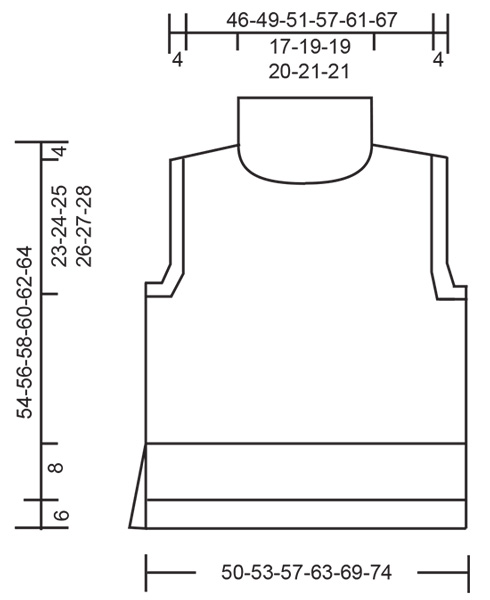 |
|
Have you finished this pattern?Tag your pictures with #dropspattern #cherrysorbetvest or submit them to the #dropsfan gallery. Do you need help with this pattern?You'll find 25 tutorial videos, a Comments/Questions area and more by visiting the pattern on garnstudio.com. © 1982-2025 DROPS Design A/S. We reserve all rights. This document, including all its sub-sections, has copyrights. Read more about what you can do with our patterns at the bottom of each pattern on our site. |
|







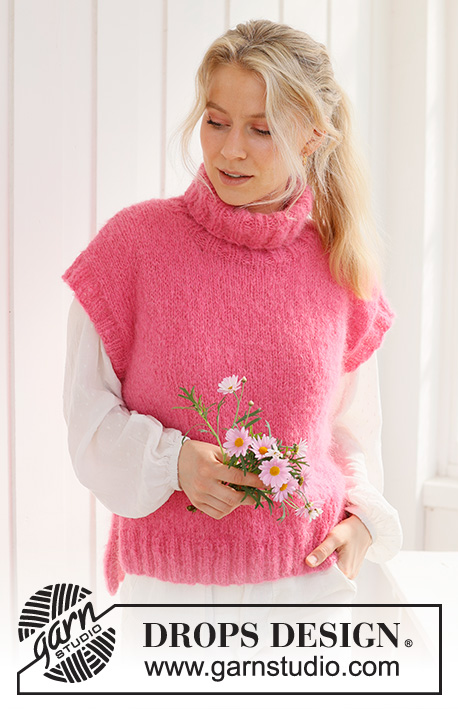

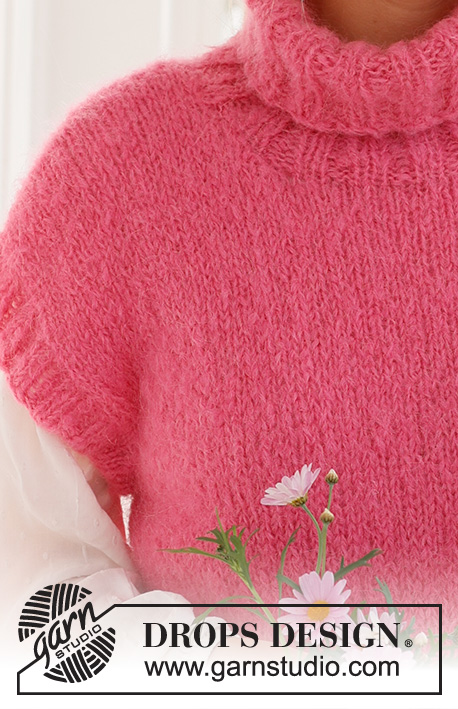
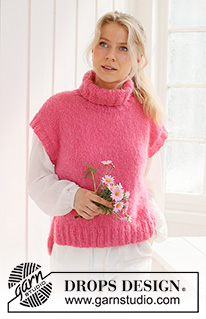
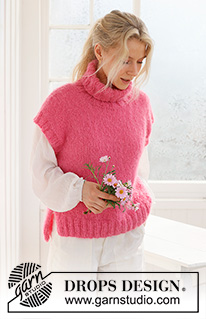




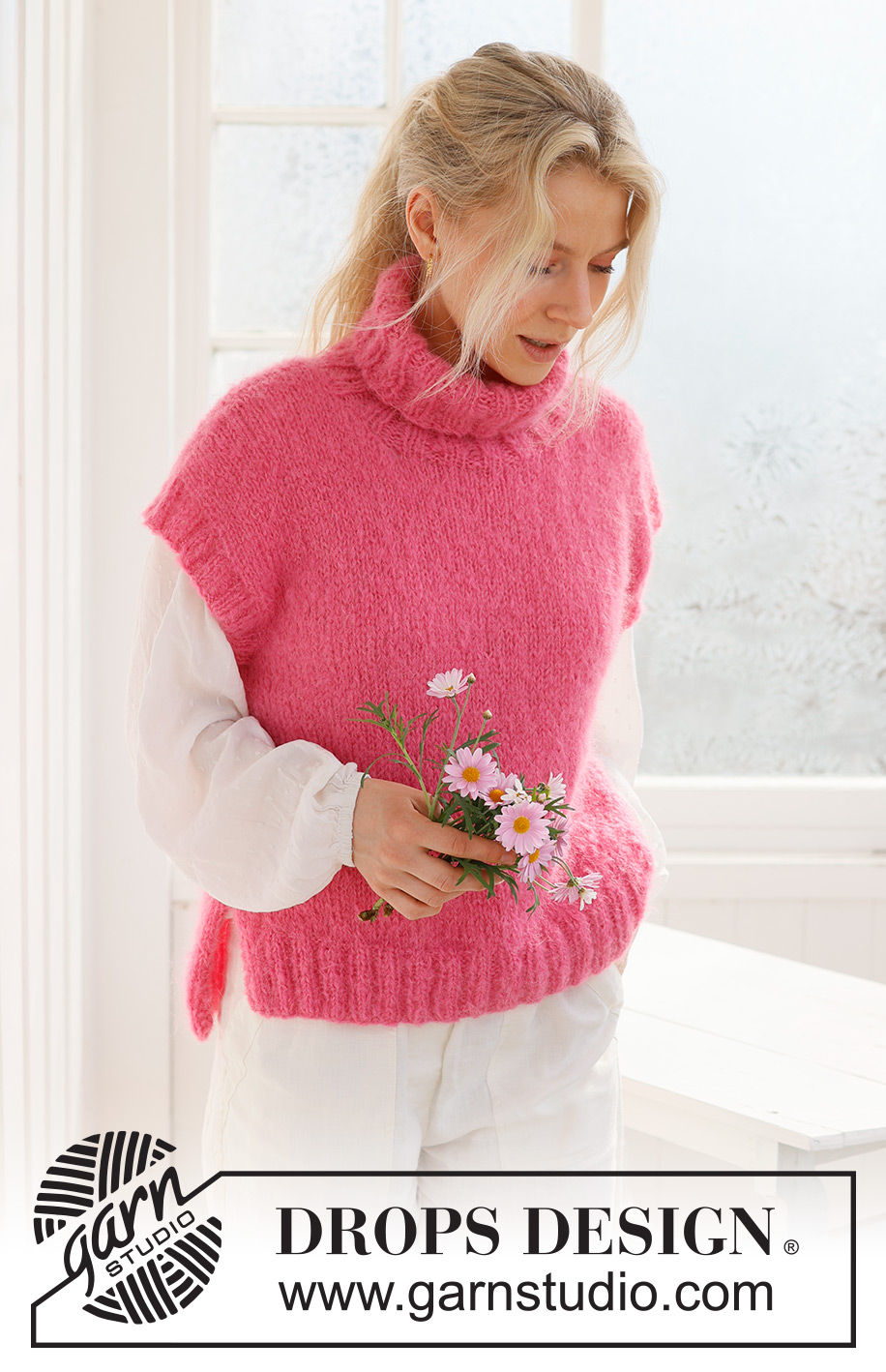

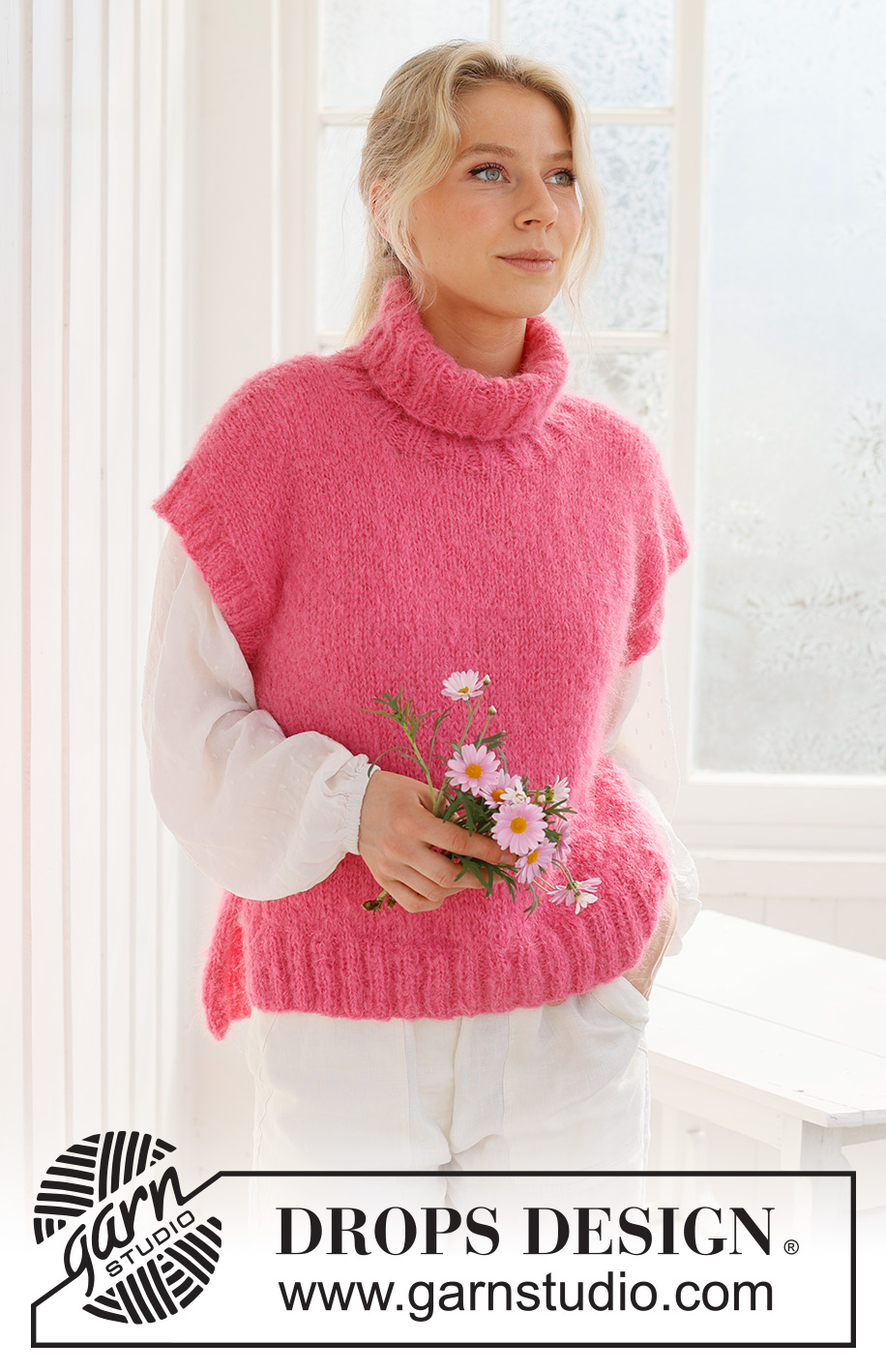
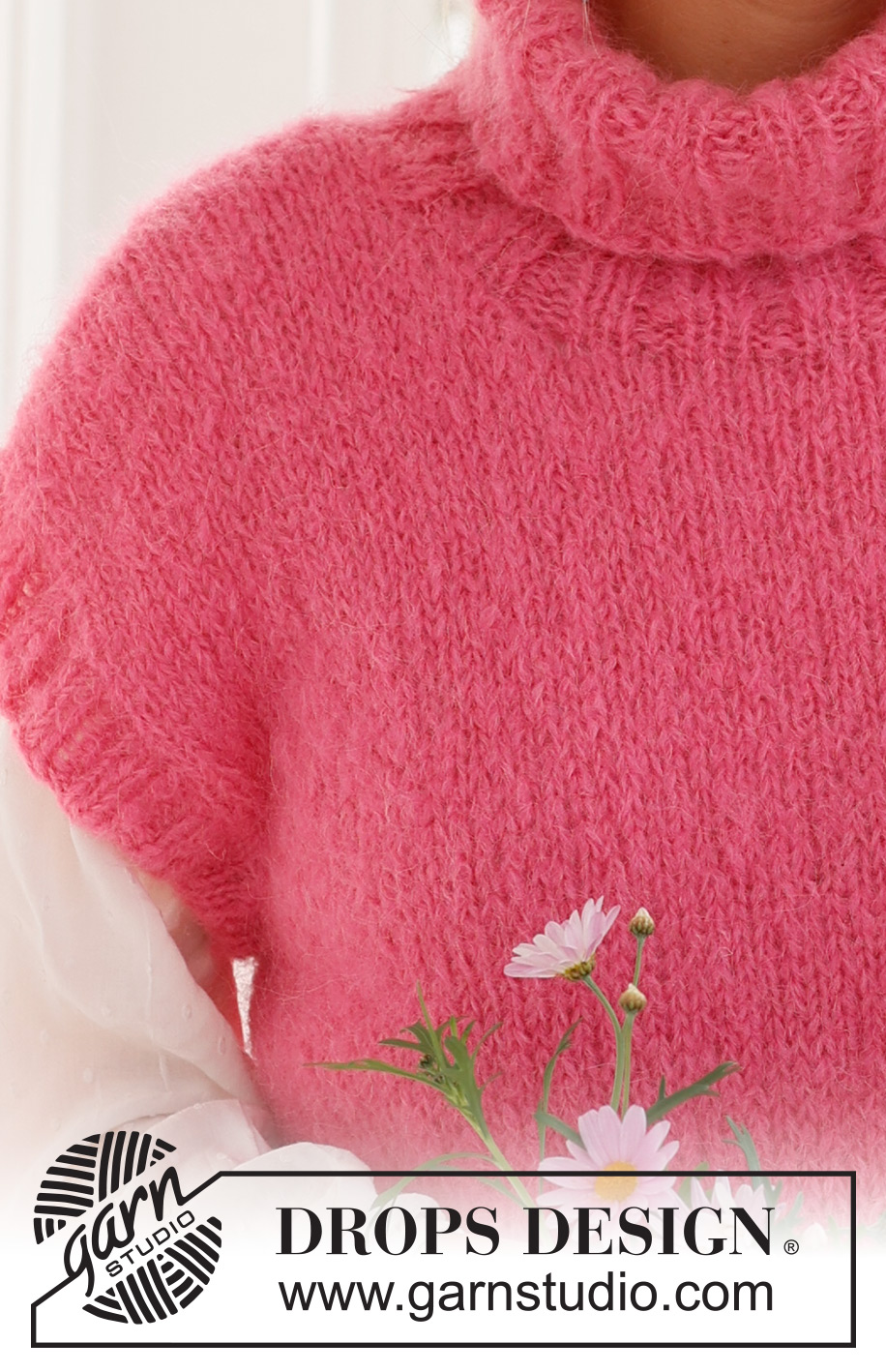


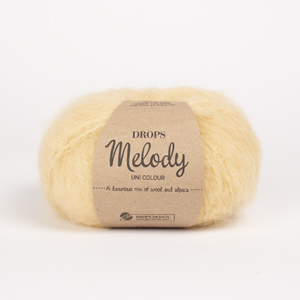









































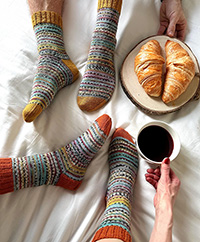
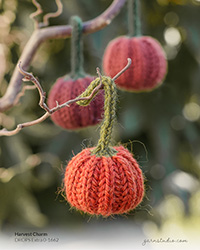



Post a comment to pattern DROPS 231-59
We would love to hear what you have to say about this pattern!
If you want to leave a question, please make sure you select the correct category in the form below, to speed up the answering process. Required fields are marked *.